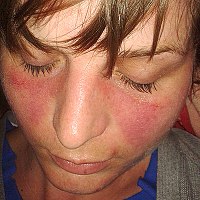
Photo from wikipedia
OBJECTIVES To explore the relationship of tumor-associated antigens (TAAs) with the clinical manifestations and serological markers of systemic lupus erythematosus (SLE). METHODS This was a retrospective study. Clinical data of… Click to show full abstract
OBJECTIVES To explore the relationship of tumor-associated antigens (TAAs) with the clinical manifestations and serological markers of systemic lupus erythematosus (SLE). METHODS This was a retrospective study. Clinical data of SLE patients were extracted from the electronic medical records, including serum levels of TAAs such as alpha-fetoprotein (AFP), carcinoembryonic antigen (CEA), cancer antigen (CA) 19-9, CA125, CA15-3, cytokeratin 19-fragments (CYFRA21-1). TAA positivity was defined as serum level exceeding the upper limit of the corresponding reference range. RESULTS A total of 149 SLE patients (SLE group) and 149 age- and sex-matched healthy subjects (control group) were enrolled. Compared with healthy controls, the SLE group had higher positivity rates for CA19-9 and CYFRA21-1, and elevated serum levels of CA125, CA15-3, and CYFRA21-1. SLE patients with TAA positivity were older, had a higher prevalence of serous effusion, pericardial effusion, albuminuria, and thrombocytopenia, and lower positivity rate for anti-dsDNA than patients without TAA positivity. The levels of serum creatinine (SCR), blood urea nitrogen, glutamic oxalate transaminase, and 24-hour urinary protein were also higher in SLE patients with TAA positivity, but platelet count and serum albumin levels were lower. On logistic regression, thrombocytopenia and SCR levels were identified as independent risk factors for TAA positivity. CA125 positivity rate and serum levels of CA125 were associated with SLE disease activity. CONCLUSION The positivity rates and serum levels of some TAAs were elevated in SLE, and thrombocytopenia and SCR levels were independent risk factors for TAA positivity.
Journal Title: Rheumatology
Year Published: 2023
Link to full text (if available)
Share on Social Media: Sign Up to like & get
recommendations!